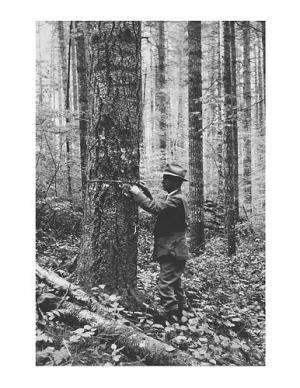Cascades study may rewrite the textbook on forest growth and death

A century-long study in the Oregon Cascades may cause scientists to revise the textbook on how forests grow and die, accumulate biomass and store carbon.
In a new analysis of forest succession in three Douglas-fir stands in the Willamette National Forest, two Oregon State University scientists report that biomass – a measure of tree volume – has been steadily accumulating for 150 years. In the long term, such a trend is not sustainable, they said, and if these stands behave in a manner similar to others in the Cascades, trees will begin to die from causes such as insect outbreaks, windstorms or fire.
"Mortality will occur in the future," said Mark Harmon, professor and Richardson Chair in Forest Science at OSU. "It just hasn't arrived."
In 1910, pioneering forest scientist Thornton T. Munger established the research plots in stands that had, by that time, been recovering from a wildfire for about 50 years. Growth and mortality were measured in the plots every five years until 1955 and again starting in 1992.
Scientists generally treat mortality as a phenomenon that occurs at an average rate over many years, said Harmon. However, results from these stands show that mortality can proceed slowly for many years and then increase rapidly in sudden pulses.
Harmon and Rob Pabst, forestry research assistant at OSU, published their findings recently in the Journal of Vegetation Science.
"The way we have thought about mortality is wrong," said Harmon, who is conducting long-term monitoring at 10 stands in the Cascades. "When we started measuring mortality, our goal was to come up with a long-term average, but it became clear that that's misleading because its very nature is variable."
After a disturbance such as a fire or a clear-cut harvest, "it takes a while for the machinery in the forest to get going," Harmon said. "And then it starts to increase biomass and hits a point where a lot of the biomass isn't being removed by tree death. But we know there are episodes of mortality: beetle kills, fire, wind storms."
Continuous accumulation of biomass over many centuries is not realistic, he added. If the tree stands they analyzed were to continue to accumulate biomass over the next 200 years, they wrote, biomass would reach world-record levels, far exceeding "what has been observed in old-growth forests of the Pacific Northwest."
"There must be some event waiting in the future that will knock them down," Harmon said. "Whether that will become more frequent in the future because of climate change or something else, I don't know."
The findings have practical implications for management of public and private forestlands. For timber production purposes, it has been common practice to harvest trees at regular intervals, usually when the rate of biomass accumulation reaches a high point. In Douglas-fir forests, that interval is often 50 to 70 years.
However, since the stands in Harmon and Pabst's study have continued to accumulate biomass steadily for 150 years, the optimum harvest cycle may be considerably longer than 50 years. It is likely, they wrote, that some Douglas-fir forests have been harvested many decades before they reached a point when the rate of biomass accumulation slowed.
The findings also suggest that these forests can continue to sequester carbon from the atmosphere well past typical harvest intervals. "While we suspect that live biomass accumulation will eventually slow down and perhaps cease, this is likely to occur many decades in the future, barring a major disturbance in these plots," they wrote. "This implies substantially more live carbon can be accumulated in this type of forest if harvest rotations are extended past the 50- to 100-year age."
More information: "Testing predictions of forest succession using long-term measurements: 100 yrs of observations in the Oregon Cascades." Journal of Vegetation Science. doi: 10.1111/jvs.12273
Provided by Oregon State University
















